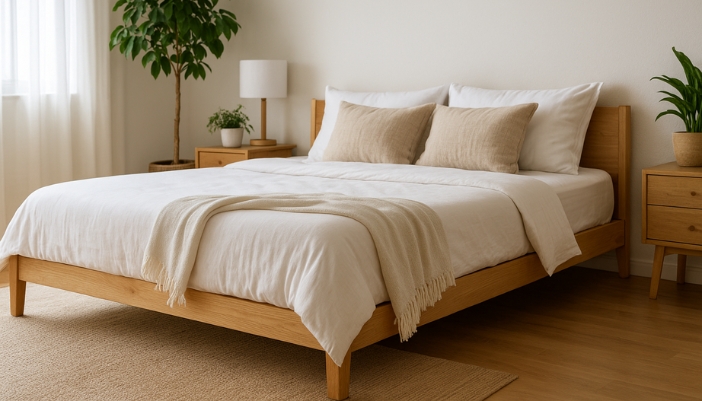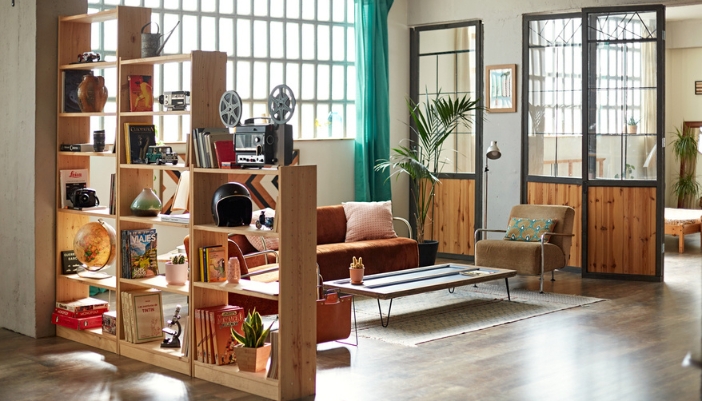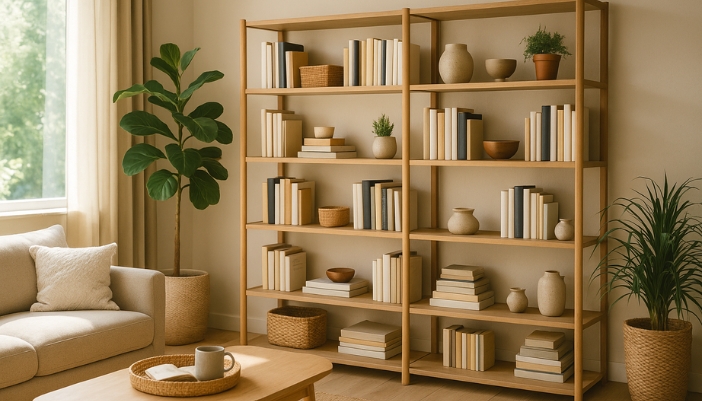If you’ve ever cranked up the AC just to feel a breeze—or laid awake in a hot, stuffy room despite the ceiling fan going full blast—you’re not alone. Sometimes, it’s not your air conditioner failing you; it’s your furniture. From bulky bookcases that block airflow to heat-trapping fabrics that leave you sweating, the wrong pieces can turn your home into a sauna.
But our experts at Hubbard and Hoke Furniture know a thing or two about keeping your space feeling fresh without driving up your energy bill. The secret? Thoughtful furniture choices that actually help air move.

Go for Elevated Furniture
If your sofa’s sitting flat on the floor, it’s more than just a dust magnet—it’s a heat trap. Elevated furniture—like sofas with legs, platform beds, and open-base tables—doesn’t just look lighter. It keeps air moving and your space feeling fresher.
- Air Circulates Freely: Raised pieces allow air to pass underneath, helping maintain even temperatures throughout the room.
- Reduces Hot Spots: With fewer solid surfaces blocking airflow, you avoid stuffy, stagnant areas, especially in tight spaces.
- Easy Maintenance: Cleaning under raised furniture is a breeze, which means less dust and allergens stuck in hard-to-reach places.
Pro Tip:
Prioritize leggy designs for rooms that feel stuffy. A sofa on sleek legs or a bed with clearance can instantly make a space feel less cramped.
Choose Open Shelving and Light Storage Solutions
Big, bulky cabinets may store a lot, but they also block airflow like a wall. That’s where open shelving shines—it looks great, keeps your space feeling airy, and doesn’t get in the way of a natural breeze.
- Minimizes Barriers: Open shelves don’t obstruct air movement, so rooms stay cooler and feel less stuffy.
- Prevents Hot Corners: Enclosed cabinets trap heat against walls, while open shelving lets air circulate even in tight spots.
- Reduces Visual Clutter: Lighter, breathable storage makes a room feel bigger, which can help air flow more easily.

Prioritize Breathable Fabrics
If you’ve ever peeled yourself off a leather sofa in the summer, you already know—fabrics matter. Heavy, synthetic materials can trap heat and leave you sweating, while breathable fabrics do the opposite, keeping you cool and comfortable.
- Wicks Away Moisture: Natural fibers like cotton and linen allow air to pass through, pulling moisture away from your skin
- Prevents Heat Build-Up: Breathable materials don’t trap body heat, so your seat stays cooler.
- Reduces Static and Stickiness: Fabrics like leather or polyester can cling and trap humidity, but light, airy fabrics stay comfortable year-round.
Pro Tip:
Look for removable, washable covers in breathable fabrics. It’s not just about staying cool—it’s about staying fresh, too.
Embrace Multi-Functional Pieces for Space Efficiency
Packed rooms don’t just look cluttered—they feel stuffy. Multi-functional furniture, like storage ottomans, fold-out desks, or sleeper sofas, keeps things light by doing double duty without taking up extra space.
- Fewer Pieces, Better Flow: A single piece that handles two jobs means fewer obstacles for air to navigate.
- Reduces Clutter: Hidden storage keeps surfaces clear, making your space feel more open and breathable.
- Adaptable Design: Foldable or expandable pieces can be tucked away when not in use, which means more open space when you need it.

Use Room Dividers Wisely for Airflow
Room dividers can be a lifesaver for privacy, but they can also choke off airflow if you’re not careful. The key? Choose dividers that guide air rather than block it entirely.
- Select Folding Screens: Lightweight, foldable dividers can be adjusted to control airflow without fully closing off a space.
- Choose Open Designs: Look for dividers made of mesh, slats, or perforated panels—these create separation without stopping air.
- Strategic Placement: Set your divider where it can help direct air from fans or windows rather than creating a dead zone.
Pro Tip:
Avoid solid, floor-to-ceiling dividers in small rooms. They may look dramatic, but they make your space feel hotter and more cramped.
Beat the Heat Without Breaking a Sweat
Nobody should feel like they’re stuck in a humid greenhouse just because they’re relaxing at home. The right furniture can keep you cool without blasting the AC all day! Don’t worry – we know which pieces help your space breathe, and Hubbard and Hoke Furniture’s experts are here to help you find them.
Got questions or need some cool ideas? Swing by our showroom (or check out our website) and explore a selection designed to keep your home comfy, even when the temps are climbing.
